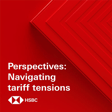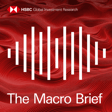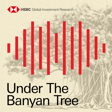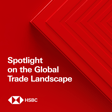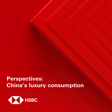Become a Creator today!Start creating today - Share your story with the world!
Start for free
00:00:00
00:00:01

Under the Banyan Tree - Are rising US bond yields good for Asia?
Herald van der Linde and Fred Neumann sit down to discuss what rising US Treasury yields could mean for savings, fund flows and company listings across Asia.
Disclaimer: https://www.research.hsbc.com/R/101/npHhLZq. Stay connected and access free to view reports and videos from HSBC Global Research follow us on LinkedIn https://www.linkedin.com/feed/hashtag/hsbcresearch/or click here: https://www.gbm.hsbc.com/insights/global-research.
Transcript
Introduction to HSBC Global Viewpoint Series
00:00:01
Speaker
Welcome to HSBC Global Viewpoint, the podcast series that brings together business leaders and industry experts to explore the latest global insights, trends, and opportunities.
00:00:13
Speaker
Make sure you're subscribed to stay up to date with new episodes. Thanks for listening, and now onto today's show.
00:00:24
Speaker
This is a podcast from HSBC Global Research, available on Apple Podcasts and Spotify. However you're listening, analyst notifications, disclosures and disclaimers must be viewed on the link attached to your media player.
Impact of US Bond Yield Rise on Asia
00:00:45
Speaker
Hello from Hong Kong and welcome to Under the Banyan Tree with me, Harold van der Linde. I'm me, Fred Neumann. On today's podcast, we're asking why are US government bond deals on the rise and what does that mean for Asia?
00:00:56
Speaker
That's right. It's one of the most important benchmarks for fund flows and investments around the world. And we're here to bring you the view from our neck of the woods. From HSBC Global Research, you're listening to Under the Banyan Tree.
00:01:16
Speaker
So, Fred, after last month's Liberation Day, markets have warbled a lot. But many things, if you look at US stock markets, they've come back to, almost back to where they were. So, I'd say a lot of the dust has settled. But if there's one thing that really hasn't settled, it's US bond yields. And we look at it because it's extremely important for us. I mean, it's a bit of a technical thing, the 10-year US bond yield. But basically, this is where mortgages and car loans are priced off, but also investments in equities and in stock markets. so This is a very important kind of benchmark for us.
00:01:50
Speaker
Before Liberation Day, it was below 4%, around 4%. And at the moment, or at least in the last week or so, it's been kind of trading a good 40, 50 basis points higher than that. That doesn't sound a lot.
00:02:04
Speaker
But if you pay 40, 50 basis points more in your mortgage, that's like hundreds of dollars more in a mortgage, right? So this is actually quite a lot.
Drivers of Higher US Bond Yields
00:02:11
Speaker
That's right. And that's um when you look at fixed income markets, often good at catching the big macroeconomic trends, right? and And you rightly say equity markets are roughly back where they were before all the tariff kerfuffle started.
00:02:26
Speaker
But on the bond yield side, we have higher interest rates now and significantly 40, 50 basis points, as you mean, is a big change. ah for 10-year bonds in the US, for example. Now, the question is, why are they higher?
00:02:39
Speaker
And one answer is that there is a bit more inflation risk because we do have tariffs coming in, even if they're bit lower than expected because of the steel in Geneva. But steel still, you get 30% – so and china China, for example, import terroristss on imports from China, still 50% roundabout.
00:02:59
Speaker
um So that's one issue but there is something else and I think that's important. We talk a lot about tariffs but there is something else that matters that's going to come up in the next few months and that is the US ah budget negotiations because the US runs a very large budget deficit.
00:03:15
Speaker
And so fixed income markets tend to reflect also concerns over borrowing requirements by a government and is they are at the moment very, very large. And so that's where a bit of uncertainty comes in and that pushes interest rates up and we could say that reflects a risk premium that's coming in. Now, that's all very technical. Why would we care about that in Asia, right?
Asian Investment Patterns and US Risk Premium
00:03:38
Speaker
We care about in and in Asia about this because Asia is a surplus-saving region. We save a lot and we lend money to the United States. And so if the risk premium in the United States goes up,
00:03:54
Speaker
That then tends to, at the margin, maybe dissuade some Asian savers maybe to pull money back out of the U.S. because, you know, and they don't they feel they might not get compensated for the risk, for example. That's right. So this is a different sort of dynamic than what we've seen in the last couple of years. Typically, if interest rates on the 10-year bond, you will go from 4 to, say, 4.5%.
00:04:18
Speaker
Asian savers would say, fantastic, we're going to put our money there. But at the moment, it's the other way around. They're taking money out, which is why point yields have to go to 4.5 to make sure that not even more money flows out.
00:04:30
Speaker
That's right. And that you always have to ask, why are interest rates going up? And obviously, that's we don't exactly know, right? We just observe interest rates going up. But one can make the observation, for example, that there is maybe a bit more risk at the moment with regards to U.S. investment. So the interest rates are going up because investors perceive a bit more risk in terms of lending into the United States. And so So the higher interest rates reflect actually Asian savers pulling back at the margin. That's one interpretation.
00:05:04
Speaker
and and And that matters, right? So if you look globally, the U.S. borrows of all the capital imports, every country that borrows internationally, the U.S. borrows about two-thirds of all global capital that's being borrowed, right? It's a massive borrower. And a lot of this money comes from Asia.
00:05:21
Speaker
yeah And so this is why why it matters. if If there is sort of at the margin, the Asian lender saying, OK, there's more risk in the US for this and that reason. Maybe there might be a stalled budget negotiations or so forth.
00:05:35
Speaker
Then they pull money back into Asia. That actually has consequences for Asian markets because it means more money is flowing over. back into local Asian markets, right? so So the Asian saver sells a U.S. bond and then has cash and needs to buy something else. And often they come closer to home. Now, this is where you come in, Harold. My question to you is – Do you see Asian savers um deploying more money into Asia?
Dynamics of Retail vs. Institutional Investments in Asia
00:06:02
Speaker
Do you see that in the data, for example, into Asian equity markets? Actually, we do.
00:06:07
Speaker
This is exactly what is happening. So we've looked at retail investors. So you've got two types of investors, institutional investors and big pension funds and these sort of big companies that make investments in the retail investors. and Well, at the start of my career 30 years ago, something like that, the institutional investors were dominating.
00:06:25
Speaker
Retail investors have really risen and in some markets are now even more important. So they're a really big sort of ah investment force to to to consider. ah What we've seen is similar trends in in the markets where we have data, but maybe the one to illustrate this is the Koreans. The Koreans have been quite, would say, aggressively buying U.S. equities over the last five or six years.
00:06:49
Speaker
The increase in U.S. holdings has gone up about six-folds, so they've really bought into that. But what we saw in April is that they sold and came back, and they put in their own market, Korean market.
00:07:02
Speaker
We saw this as well with Japanese investors, but not as, I would say, as aggressive or as dramatic as the Korean investors. And this has been counteracted in Japan by pension funds who actually bought into the U.S. So the dynamics there are a little bit different.
00:07:18
Speaker
Now, we have this also for other markets, Taiwan, for example, but um that that seems to have been the trend. People have been selling the US s and come back. So this is absolutely the case. The one market where things are really different is India.
00:07:30
Speaker
ah They've been buying their own stock market over the last couple of years. That market has seen a bit of correction. So they've pulled back from that. But what you have in India, which is a bit unique, is that they have so-called systematic investment plans, which is sort of a monthly investment plan.
00:07:44
Speaker
And very often people subscribe to that and then actually forget about it. Right. So that is continuing. So they're still buying. And that is actually holding that market up to a large extent. That's interesting. um and And I think it's worth just taking a quick step back here because, um you know, for many, many years, Asia had been excess saving region for decades and lent money to the United States.
00:08:10
Speaker
ah That's been the typical pattern. But things have changed gradually. the the The pool of Asian savings has become so large now that in itself, if there is repatriation of capital from the United States back into Asia, it could actually have macroeconomic facts on on Asia.
00:08:29
Speaker
Whereas previously, there was a bit coming back and it was mostly central banks that were reluctant to repatriate funds and it wasn't the the quantity of of of capital wasn't quite there. Now it's very, very large.
00:08:41
Speaker
What implications would that, for example, be for you? So so one implication here is that um we tend to think, OK, a weaker U.S. s economy, bigger risk in the U.S., maybe U.S. slows down, would be bad for Asian growth.
00:08:54
Speaker
um And a weaker U.S. dollar would maybe signify that there's weaker U.S. growth and therefore that ultimately impacts growth in Asia. And that's because we sell fewer exports into Asia.
00:09:05
Speaker
Yeah. Now though, there is a capital flow channel. So that is, we have weaker growth in the US, the dollar weakens, money comes back into Asia. And yes, our exports to the US s slow down because of the slowdown in the US, but we have suddenly all this capital coming back into Asia. Actually, there's so much capital coming back that it lowers funding costs for companies here. And they can therefore invest. and they can therefore invest. And actually there could therefore be a positive growth impact of all this money coming back.
00:09:34
Speaker
um And and that's that's how large these flows have become. And so what we might see is actually that now there is a financial maturity in Asia. There's so many savings that ultimately as it pulls back savings out of the United States.
00:09:47
Speaker
um that that is is could be a growth enhancing for for the rest of the region. an extreme example of this probably is China, because China's got capital controls. There's a lot of money there. We've spoken about it before. There's 22 trillion US dollars in cash in bank deposits, and that's from households, or families.
00:10:05
Speaker
If you add the companies to it, there's another 10 trillion there, so you end up with 32. So this is an enormous cash pile in China.
Local Investment Trends in China and IPO Demand
00:10:13
Speaker
And what we've actually seen that that is now being deployed as well. I mean, they've lowered the the cost of funding, as you called it, in in China already. There's very low interest rates there.
00:10:22
Speaker
But you see that some of that money actually is now coming into the equity market as well. Into Hong Kong and in particular. where You see that in Hong Kong and and you see certainly Chinese savers have so much money at the moment, liquidity to deploy. They're obviously looking for opportunities. so and Some of the the flow has obviously then come to Hong Kong, right? Through the southbound connect and it's now being invested here. yeah i suppose some of it would have also flown into the United States, but that money also might now be coming back into Hong Kong. yes Rather than going through Hong Kong and the United States, it might actually be deployed here in Asia because of that perceived greater risk in the U.S. tactically, right? We're not necessarily making assumptions about long-term investment. but But that seems to be a tactical observation. But um that that raises another question. So if there is a lot of money –
00:11:08
Speaker
are sloshing around Asia at the moment and your investors are looking for investment opportunities, that should be a good time to see more IPOs in Asia, Harold. And maybe that's a great time to take a quick break. And when we come back, I want to grill you on those IPOs, Mr. Equity Strategy. Fantastic. Bring it on.
00:11:36
Speaker
So Harold, before the break, we talked about the fact that Asia has enormous amounts of savings. Historically, a lot of these were deployed into the United States. Now we see … Some them coming back. Some of them coming back. Now, what does this mean for Asian companies if as this money comes back? now They face lower interest rates because there's more capital coming back into this region.
00:11:56
Speaker
um But for equity listings, that should also be an opportunity for a company to say, hey, let's list ourselves on the stock market here because there is suddenly more demand for Asian equities by local savers. Is that right?
00:12:09
Speaker
Yeah, so the potential demand for people to buy into companies is very high. There's a lot of people sitting on cash, as we me just mentioned, so they're looking for opportunities. There's, of course, a lot of companies listed already, um but we've seen, actually, that more and more companies are listing. Now, funnily enough, in certain markets, the IPO market, and so that's the market by initial public offering, where people, companies, for the first time sell their shares in the stock market or through the stock market,
00:12:33
Speaker
and Just going around the region very quickly, in Korea and in Taiwan, for example, it's been very quiet. There have been IPOs, but not really big IPOs. Anything where companies raise less than $300 million, dollars we consider it to be small.
00:12:47
Speaker
and So that's predominantly been smaller companies. so locals like that, but it's not that foreign investors isn't really focus into this. The one market that used to be really big in IPOs 10 years ago was Hong Kong.
00:12:58
Speaker
And over the last five years or so, it's been very extremely quiet, hardly any IPOs because the market was not performing very well, etc., etc. So the appetite, demand for IPOs was very very weak, but that's increasing now.
00:13:13
Speaker
And we've suddenly seen a revival in that. Suddenly, most of the money raised by mainland Chinese companies, firms at the moment, actually is done in in Hong Kong. But bringing that back to a larger point, which is that we have such enormous amounts of savings in Asia that traditionally were lent into the United States, but we see now money coming back.
00:13:32
Speaker
That then means that Asian markets are deepening, yeah that you see more Asian investors buying Asian companies. And and does this fit the trend then?
00:13:43
Speaker
Yes and no. Yes, in certain markets. We've seen this in, I think India is a great example. More domestic buyers of stocks, ah more companies that have listed in India. They tend to be mid and small cap companies that the Indian local Indian investors know, but foreign investors wouldn't normally go because they don't know these companies very well.
00:14:04
Speaker
So in India, that's worked out. In Hong Kong, that's worked out over the last decades as well. The one region where this is not really working, I think, is ASEAN. We actually see in Singapore more companies taking their shares off the market instead of putting new shares on. So they're delisting instead of listing.
00:14:21
Speaker
Malaysia is quite active, but Indonesia, Thailand, some of the other markets, they need to see more IPOs. And they have and five, six years ago. There was a lot of IPOs in that market. But it would be nice if they would revive as well because those markets would really benefit from ah broadening of the supply of companies that are listed in that market.
00:14:38
Speaker
But isn't that maybe also just a reflection of the global macro environment that in the last five, six, seven, eight years, actually most of the capital globally has flowed into the United States? Yeah.
00:14:50
Speaker
ah particularly out of emerging markets and the small emerging markets like Southeast Asia. Are more sensitive to that. More sensitive to that and that kind of drain a little bit the life out of these equity markets. yeah But now if that were to reverse, that would probably… Yeah, on the margin, that those could be the biggest beneficiaries of this as well because as you say, they're smaller and therefore they get disproportionately impacted if there's a shift in inflows, absolutely.
00:15:14
Speaker
Yep. There you go.
Conclusion: Positive Outlook for Asian Markets
00:15:15
Speaker
So, Harold, it's not all doom and gloom. you know No? There might be higher risk premium in the U.S., but actually could not be too bad for Asian markets. Sounds like you're becoming a strategist, ah Fred. Well, I'll stay well clear of that. I've seen you you know call it right and wrong for so many years. I'll stay away from that game. Okay.
00:15:33
Speaker
um But yeah, anyways, feels like a good point to wrap up this week's conversation. Thanks to all our listeners for joining us. And do listen, like and subscribe to the macro brief from HSBC Global Research if you haven't already.
00:15:44
Speaker
From all of us here in Hong Kong, have a great rest of your week and we'll talk to you again very soon.
00:16:17
Speaker
Thank you for joining us at HSBC Global Viewpoint. We hope you enjoyed the discussion. Make sure you're subscribed to stay up to date with new episodes.


